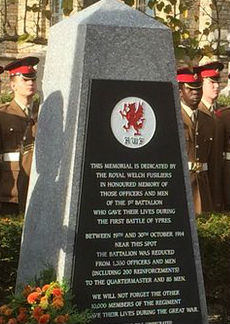At the beginning of the Battle of Ypres, the 1.100 men strong Royal Welch Fusiliers marched 120 miles to join the effort to push the Hun out of Belgium. Little did they know that the ranks of the enemy had been swelled by volunteers. In just two days of bombardment, their ranks had been cut to just 200, before receiving reinforcements.
On Sunday 26 October, a ceremony near the village of Zandvoorde unveiled a memorial to the Royal Welch Fusiliers, and at nearby Gheluvelt there were ceremonies to mark the losses of the South Wales Borderers, and the Household Cavalry. Welsh families were in Belgium to mark the ceremony being held for the more than 1,100 men killed in the surrounding countryside of Ypres.
The First Battle of Ypres marks the introduction of trench warfare. The large-scale introduction of rapid firing machine guns made cavalry charges and frontal assaults by waves of troops obsolete. It would take another 3 years to break the stalemate of the entrenchment system.
The Royal Welch Fusiliers, 1st Battalion, was annihilated over 20 days of vicious fighting in October of 1914 when a failed attack resulted in having to take defence against constant German shelling. After an initial setback reducing their numbers to about 200, they received reinforcements bringing their numbers back to around 400.
On 30 October 1914, 275 were killed, and 50 were wounded or taken prisoner. Only 86 men remained by the following morning. The 1st Battalion was reformed while the battle carried on for another few weeks, the BBC News reports.
Lt Col Henry “Hal” Osbert Samuel Cadogan, the battalion commander, was killed in action on that fateful day, trying to reach a younger officer, Claud Doomer, with the battalion surrounded at Zandvoorde. A career officer with service in India and China, he was drafted in from Malta with the war being declared. He is remembered in a book written by his grandson, also a regimental veteran, Col (Ret) Henry Cadogan of Wrexham.
“More shells were fired in those weeks than in the whole of the Boer War,” said Col Cadogan. “They would never have seen anything like it. But it was important because they stopped the Germans by the skin of their teeth getting through to the coast – it would have been the end of the war. These were the last of the Old Contemptibles – the regular Army that was available. Afterwards, they relied on recruitment back home. There are no letters from the front to my grandmother but she received a message in pencil from the brigadier, he wrote that the Royal Welch Fusiliers had ‘practically disappeared.’ It’s frightful. That’s why it’s very important we remember.”
Royal Welch Fusiliers Memorial at Zandvoorde- On 30 October 1914, 275 were killed, and 50 were wounded or taken prisoner. 86 men remained by morning.
Attachments:
Royal Welch Fusiliers Memorial
Royal Welch Fusiliers Memorial unveiled at ceremony.
Message from Brigadier
Message to Eve Cadogan from the brigadier, shortly before her husband was killed.
“I can’t tell you how terribly sorry I am to say that the Welch Fusiliers have practically disappeared. I expect you know how enormous these losses were lately both on officers and men – up to yesterday morning there were five officers, 450 others. Your husband, [Claud] Dooner, Poole and two boys were all [that was] left of the officers.
